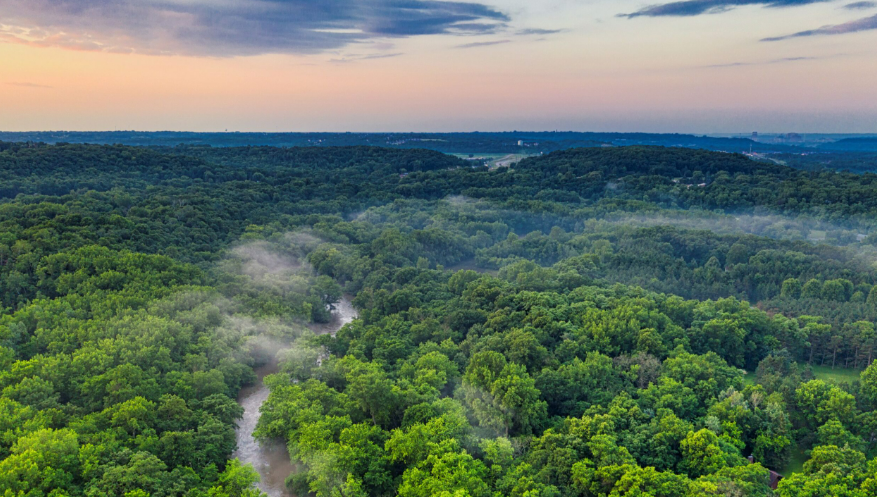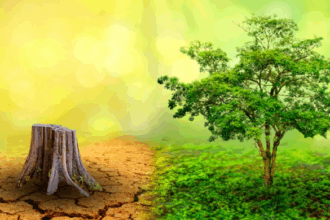Forests and wildlife are valuable natural resources that support life on Earth. They provide us with food, fuel, medicines, raw materials and maintain ecological balance. However, due to increasing human activities like deforestation, mining, and urbanisation, many plant and animal species are disappearing rapidly. To protect our environment and biodiversity, it is important to understand the importance of forests and wildlife, the reasons for their depletion, and the measures taken to conserve them in India.
Introduction
1. India’s rich biodiversity:
India is one of the world’s richest countries in terms of biological diversity. It has a wide variety of plants, animals, and microorganisms found in different climatic conditions.
2. Variety of species:
India is home to about 8% of the total number of species in the world, which includes millions of different life forms.
3. Significance of forests and wildlife:
Forests and wildlife are very important for maintaining ecological balance.
- Forests provide oxygen, timber, fuel, fruits, and herbs.
- Wildlife helps in maintaining the food chain and supports the natural ecosystem.
4. Depletion of resources:
But today, forests and wildlife are declining rapidly due to human activities like deforestation, overgrazing, mining, and industrialization.
5. Need for conservation:
Conservation of forests and wildlife is necessary to maintain the ecological balance and preserve biodiversity for future generations.
Topic-1: Flora and Fauna in India
1. Meaning of Flora and Fauna:
- Flora means plants and vegetation found in a region.
- Fauna means animal life of that region.
2. India’s rich biodiversity:
- India has around 47,000 plant species and about 90,000 animal species.
- It is one of the 12 mega biodiversity countries in the world.
3. Variety due to diverse climate:
- India’s varied climate, soil, and relief support different types of forests, trees, herbs, grasses, and animals.
- For example – Tropical rainforests in the Western Ghats and deserts in Rajasthan have very different plant and animal life.
4. Endemic species:
- Some species of plants and animals are endemic, which means they are found only in India, like the Indian rhinoceros, Asiatic lion, and Indian giant squirrel.
5. Extinction threat:
- Many species of plants and animals are now endangered or extinct due to human activities such as deforestation, hunting, and pollution.
6. Importance of biodiversity:
- Flora and fauna maintain ecological balance and are important for human survival, economy, and culture.
Topic-2: Vanishing Forests
1. Rapid decline:
Forests in India are disappearing quickly due to human and natural causes.
2. Main causes of forest loss:
- Deforestation – Clearing forests for agriculture, industries, and urban areas.
- Mining and large projects – Construction of dams, roads, and industries destroy forest land.
- Overgrazing – Excessive grazing by cattle damages young plants and grasslands.
- Shifting cultivation – In some tribal areas, forests are cut and burnt to grow crops.
- Firewood and timber use – Overuse of wood for fuel, furniture, and construction reduces forest cover.
3. Impact of vanishing forests:
- Loss of biodiversity (many plant and animal species disappear).
- Increase in soil erosion and floods.
- Climate change due to loss of trees that absorb carbon dioxide.
- Disturbance in ecological balance.
4. Need for conservation:
Forests are vital for life on Earth, so they must be protected, replanted, and used wisely through afforestation and sustainable management.
Topic-3: IUCN’s Classification
1. Meaning:
The IUCN (International Union for Conservation of Nature) is an organization that classifies plants and animals based on how threatened or safe they are from extinction.
2. Purpose:
This classification helps in identifying species that need protection and in planning conservation programs.
3. Main Categories of IUCN Classification:
- Normal Species:
- Species whose population is normal or stable.
- Example: Cattle, sal trees.
- Endangered Species:
- Species that are very few in number and likely to become extinct soon if not protected.
- Example: Tiger, Indian rhinoceros.
- Vulnerable Species:
- Species whose population is declining rapidly and may soon become endangered.
- Example: Blue sheep, Asiatic elephant.
- Rare Species:
- Species with small populations found in limited areas, and may become endangered if conditions worsen.
- Example: Himalayan brown bear, wild Asiatic buffalo.
- Endemic Species:
- Species that are found only in a particular region or country and nowhere else in the world.
- Example: Nicobar pigeon, Andaman teal.
- Extinct Species:
- Species that have completely disappeared from the Earth.
- Example: Asiatic cheetah, pink-headed duck.
Topic-4: Asiatic Cheetah- Where did they go?
1. Once found in India:
Asiatic cheetahs were once widely found in India, especially in Rajasthan, Gujarat, and parts of Madhya Pradesh.
2. Reasons for their disappearance:
- Hunting:
- Cheetahs were hunted in large numbers by kings and British officers for sport.
- Loss of habitat:
- Expansion of agriculture and human settlements destroyed grasslands, their natural home.
- Decline in prey animals:
- Due to hunting and habitat loss, animals that cheetahs hunted (like deer) became fewer.
- Use in hunting by kings:
- Cheetahs were captured and trained for hunting, reducing their wild population.
3. Extinction in India:
- The last three Asiatic cheetahs were killed in 1947 in India.
- In 1952, the Indian government officially declared them extinct in the country.
4. Present status:
- Today, a small number of Asiatic cheetahs survive only in Iran, making them one of the rarest big cats in the world.
Topic-5: Depletion of Flora and Fauna
1. Meaning:
Depletion of flora and fauna means the reduction or loss of plant and animal species in a region.
2. Main Causes of Depletion:
- Deforestation:
- Large-scale cutting of trees for farming, industries, houses, and roads reduces forest cover.
- Overexploitation of Resources:
- Excessive use of forest products like timber, firewood, and medicinal plants leads to scarcity.
- Hunting and Poaching:
- Hunting animals for their skin, horns, fur, and meat has reduced many species drastically.
- Habitat Destruction:
- Construction of dams, mining, and expanding agriculture destroy the natural homes of many species.
- Overgrazing:
- Too many cattle grazing in one area destroys grasslands and young plants.
- Urbanisation and Industrialisation:
- Growing cities and industries occupy forest lands and pollute the environment, harming plants and animals.
- Pollution:
- Air, water, and soil pollution affect the survival of many species.
- Environmental Factors:
- Natural disasters like floods, droughts, and forest fires also reduce biodiversity.
3. Effects of Depletion:
- Loss of biodiversity
- Imbalance in ecosystem
- Increase in soil erosion
- Extinction of many species
- Climate change and global warming
4. Need for Conservation:
Protecting forests and wildlife is necessary to maintain ecological balance and ensure sustainability for future generations.
Topic-6: Impact of destruction of forests and wildlife
1. Loss of Biodiversity:
- Many plant and animal species become endangered or extinct, reducing the variety of life on Earth.
2. Imbalance in Ecosystem:
- Every species plays a role in nature.
- When plants and animals disappear, the food chain breaks, causing ecological imbalance.
3. Soil Erosion and Floods:
- Trees hold soil with their roots.
- When forests are cut, soil gets washed away easily, leading to soil erosion, floods, and landslides.
4. Climate Change:
- Trees absorb carbon dioxide.
- When forests are destroyed, CO₂ increases in the atmosphere, causing global warming and temperature rise.
5. Loss of Livelihoods:
- Forests provide food, fuel, medicine, and employment to millions.
- Their destruction harms tribal communities and forest-dependent people.
6. Reduced Rainfall:
- Forests help in maintaining the water cycle.
- Loss of forests leads to less rainfall and drought-like conditions.
7. Decline in Wildlife Population:
- Animals lose their natural homes, leading to migration, conflict with humans, and sometimes extinction.
8. Increase in Natural Disasters:
- Without forests, the frequency of floods, droughts, cyclones, and landslides increases.
9. Loss of Medicinal Plants:
- Many plants used in medicines disappear, affecting healthcare and traditional knowledge.
Topic-7: Conservation of forests and wildlife in India
1. Meaning of Conservation:
Conservation means protecting, preserving, and managing forest and wildlife resources so they can be used sustainably.
2. Why Conservation is Important?
- To maintain ecological balance.
- To protect biodiversity.
- To prevent extinction of species.
- To ensure resources for future generations.
3. Steps Taken for Conservation in India
a) Indian Wildlife Protection Act, 1972
- A major law to protect plants and animals.
- Bans hunting, poaching, and trading of endangered species.
- Provides legal support to national parks, wildlife sanctuaries, etc.
b) Establishment of Protected Areas
- To protect natural habitats of animals.
- National Parks – No human activity allowed.
- Wildlife Sanctuaries – Limited human activity allowed.
- Biosphere Reserves – Protect big areas of wildlife and culture.
c) Project Tiger
- Started in 1973 to protect tigers from extinction.
- Helped increase the tiger population.
d) Project Rhino & Project Elephant
- Special programs to protect one-horned rhinoceros and elephants.
e) Joint Forest Management (JFM), 1988
- Involves local communities in protecting forests.
- People and government work together to manage forests.
f) Afforestation and Reforestation
- Planting new trees and restoring degraded forests.
g) Community and NGO Efforts
- Movements like Chipko Movement (hugging trees to prevent cutting).
- NGOs spread awareness and help in forest protection.
h) Government Awareness Campaigns
- Programs like Van Mahotsav, school curriculum, and media campaigns encourage conservation.
4. Result of Conservation Efforts
- Increase in tiger numbers.
- Better protection of endangered species.
- Increased awareness among people.
- Restoration of degraded forests.
Topic-8: Project Tiger
1. What is Project Tiger?
Project Tiger is a wildlife conservation programme started by the Government of India to protect tigers and their forests.
When was it launched?
It was launched in 1973.
Why was it needed?
- Tiger population had reduced sharply due to poaching, habitat loss, and deforestation.
- Tigers were becoming endangered.
2. Main Objectives of Project Tiger
- Increase the number of tigers in India.
- Protect tiger habitats (forests and grasslands).
- Stop poaching and illegal trade of tiger skins and bones.
- Reduce human–tiger conflict in forest areas.
- Create proper management of tiger reserves.
3. Tiger Reserves
- Under this project, special forest areas called Tiger Reserves were created.
- India now has more than 50 tiger reserves.
Some important tiger reserves (from NCERT):
- Corbett (Uttarakhand)
- Sunderbans (West Bengal)
- Ranthambore (Rajasthan)
- Bandhavgarh (Madhya Pradesh)
4. Impact of Project Tiger
- Tiger population has increased over the years.
- Large forest areas have been protected.
- Awareness about wildlife conservation has improved.
Topic-9: Types and Distribution of forests
India’s forests are divided into three categories based on who controls and manages them.
1. Reserved Forests
- Most protected category of forests.
- No public access allowed without permission.
- Cutting trees, grazing, hunting, and exploiting resources are totally restricted.
- Aim: Protect forests and wildlife strictly.
- These forests have very high conservation value.
Examples:
- Madhya Pradesh has the largest area under Reserved Forests.
2. Protected Forests
- Less restricted than reserved forests.
- Some activities like grazing may be allowed but under control.
- The government protects the forest, but local people may use it for limited needs.
Examples:
- Most protected forests are found in Andhra Pradesh, Maharashtra, Rajasthan.
3. Unclassed Forests
- These are forests and wastelands that do not fall under reserved or protected forests.
- They are often under:
- Local communities,
- Private owners, or
- District administration.
- Very low protection and high risk of misuse.
Examples:
- Nagaland, Assam, and parts of the Northeast have the largest share of unclassed forests.
Topic-10: Community and Conservation
1. Meaning
Local people and communities play an important role in protecting forests and wildlife. Their participation makes conservation more effective and long-lasting.
2. Role of Local Communities
- Communities help protect, manage, and conserve forests and wildlife.
- They use resources sustainably and understand local ecosystems better.
- They stop illegal activities like poaching, timber smuggling, and forest fires.
3. Examples of Community Initiatives
a) Chipko Movement (1973) – Uttarakhand
- Villagers, especially women, hugged trees to stop them from being cut.
- Helped spread awareness about forest conservation across India.
b) Joint Forest Management (JFM), 1988
- Government and local people work together to protect and manage forests.
- Communities get benefits like fuelwood, fodder, and share of timber.
c) Community Forests in Odisha
- Villagers protect the Sal forests from fire, grazing, and illegal cutting.
- Forest cover has increased due to community efforts.
d) Beej Bachao Andolan – Uttarakhand
- Farmers protect indigenous seeds and promote organic farming.
- Helps in conserving plant biodiversity.
4. Sacred Groves
- Certain forest patches are protected because they are considered sacred.
- No one is allowed to cut trees or hunt animals there.
- Common in Rajasthan, Madhya Pradesh, Meghalaya, Karnataka.
- These groves help preserve rare species and maintain biodiversity.
5. Importance of Community Participation
- Better protection of forests and wildlife.
- Reduction in forest fires, poaching, and illegal logging.
- Helps conserve local biodiversity.
- Improves awareness and encourages sustainable use of resources.
- Strengthens the relationship between people and nature.
Conclusion
Forests and wildlife are essential for the survival of all living beings. Their destruction leads to ecological imbalance, climate change, and loss of biodiversity. Therefore, conservation is not just the responsibility of the government but also of local communities and individuals. Through national parks, wildlife sanctuaries, projects like Project Tiger, and community participation, India is working towards protecting these resources. If we use forests and wildlife wisely and protect them for the future, we can maintain a healthy and sustainable environment.
Full Chapter Explanation
Detailed notes of other chapters:
Resources and Development: Class-10th Geography Chapter-1 ( Easy NCERT Notes )






